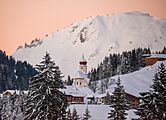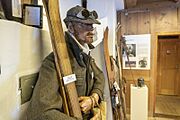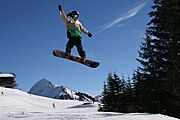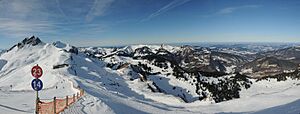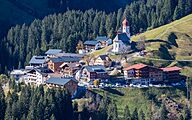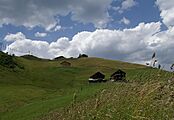Damüls facts for kids
Quick facts for kids
Damüls
|
||
|---|---|---|
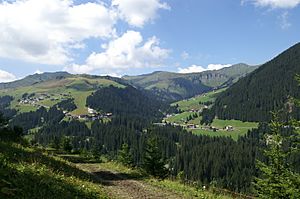 |
||
|
||
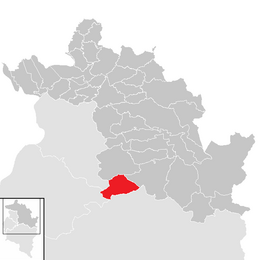
Location in the district
|
||
| Country | Austria | |
| State | Vorarlberg | |
| District | Bregenz | |
| Area | ||
| • Total | 20.91 km2 (8.07 sq mi) | |
| Elevation | 1.428 m (4.685 ft) | |
| Time zone | UTC+1 (CET) | |
| • Summer (DST) | UTC+2 (CEST) | |
| Postal code |
6884
|
|
| Website | http://www.damuels.at/ | |
Damüls (called Alemannic German: Dimülsch by locals) is a small village in Austria. It's a popular place for tourists. You can find it in the Bregenz area, which is part of the state of Vorarlberg in western Austria.
Damüls is super famous for how much snow it gets! In 2006, it even earned the special title "the snowiest village in the world."
Contents
People Living in Damüls
The number of people living in Damüls has changed over many years. Here's a look at how the population has grown and shrunk:
| Historical population | ||
|---|---|---|
| Year | Pop. | ±% |
| 1869 | 383 | — |
| 1880 | 365 | −4.7% |
| 1890 | 278 | −23.8% |
| 1900 | 241 | −13.3% |
| 1910 | 225 | −6.6% |
| 1923 | 204 | −9.3% |
| 1934 | 218 | +6.9% |
| 1939 | 209 | −4.1% |
| 1951 | 223 | +6.7% |
| 1961 | 241 | +8.1% |
| 1971 | 322 | +33.6% |
| 1981 | 304 | −5.6% |
| 1991 | 309 | +1.6% |
| 2001 | 326 | +5.5% |
| 2011 | 316 | −3.1% |
Where is Damüls Located?
Damüls is high up in the mountains, about 1,430 meters (that's almost 4,700 feet) above sea level. The village covers an area of about 20.92 square kilometers.
It's surrounded by beautiful natural areas like the Bregenz Forest and the Biosphere Reserve Großes Walsertal. Damüls also shares borders with other parts of Vorarlberg, like Bludenz, Feldkirch, and Dornbirn.
A famous mountain nearby is the Damülser Mittagsspitze. It's 2,095 meters (about 6,873 feet) tall and a favorite spot for hikers starting from Damüls.
A Look at Damüls' History
Around the year 1300, a group of people called the Walsers moved to this area. They came from a place in Switzerland called Wallis. They were looking for a better life and more land for farming.
The Walsers were allowed to settle in Vorarlberg, which was then controlled by the Counts of Montfort. They also settled in parts of Tyrol and Graubünden. By 1313, Walsers had made Damüls their home.
Back then, Damüls and a nearby village called Fontanella were quite independent. The people of Damüls even promised to help the Montfort family in wars, fighting with "spear and shield."
Culture and Traditions
Damüls has a rich culture with many old traditions that are still important today.
Local Customs and Dialect
One special thing is the local dialect, which is still spoken by many people. It's a unique way of talking that has been passed down through generations.
People also wear traditional folk costumes, called "tracht," for special events. This helps keep the old-time feeling alive.
Church of St. Nikolaus
The Church of St. Nikolaus is a very important building in Damüls. It's known for its beautiful old frescoes (paintings on walls). These frescoes are like a "Bible for the poor," telling stories through pictures. The church dates back to the 13th or 14th century, when the Walsers first arrived.
FIS Skimuseum Damüls
The FIS Skimuseum Damüls is a museum all about skiing in Vorarlberg. You can see old and rare skis and even items related to ski jumping. It's a great place to learn about the history of skiing, and entry is free!
Alpine Transhumance (Dreistufenwirtschaft)
A very old farming tradition still practiced in Damüls is called Alpine transhumance. It's also known as "Dreistufenwirtschaft" in German, which means "three-stage farming."
Here's how it works:
- Farmers move their cows to different mountain pastures throughout the year.
- They go to lower pastures in spring, middle pastures in summer, and higher pastures later in the summer.
- This helps the cows find the best food as the seasons change.
This tradition is important for keeping the natural landscape healthy. It also helps with making delicious cheese, which Vorarlberg is famous for. In 2011, UNESCO recognized this "Dreistufenwirtschaft" in the Bregenz Forest as an important cultural heritage.
Fun for Tourists
Damüls is a fantastic place for visitors, especially if you love snow and the outdoors!
Skiing and Snow Fun
In 2010, the ski areas of Damüls and Mellau joined together. This created the largest ski area in the Bregenz Forest and one of the biggest in all of Vorarlberg: the ski area Damüls-Mellau.
As mentioned, Damüls is famous for its snow. On average, it gets about 9.30 meters (over 30 feet) of fresh snow every winter!
There's also a 2.5-kilometer (about 1.5-mile) long natural toboggan run. It's even lit up two nights a week for evening sledding!
Hiking and Summer Activities
Even in summer, Damüls is a wonderful place to visit. Many hiking trails start from the village. You can walk through beautiful alpine meadows and climb to mountain tops. From there, you'll get amazing views of the surrounding mountains. The temperatures are usually very pleasant, even when it's hot in other places.
Photo gallery
See also
 In Spanish: Damüls para niños
In Spanish: Damüls para niños




